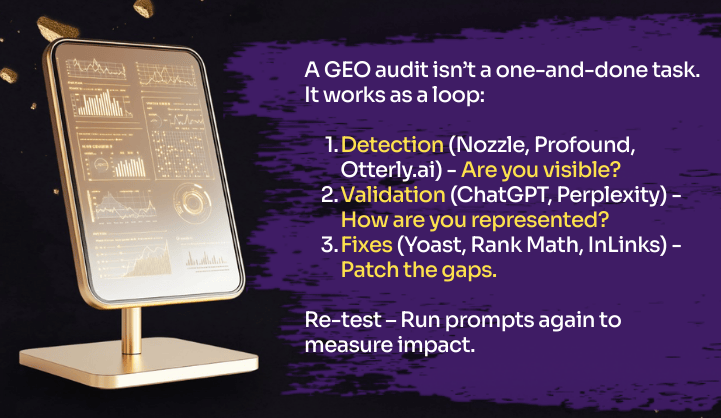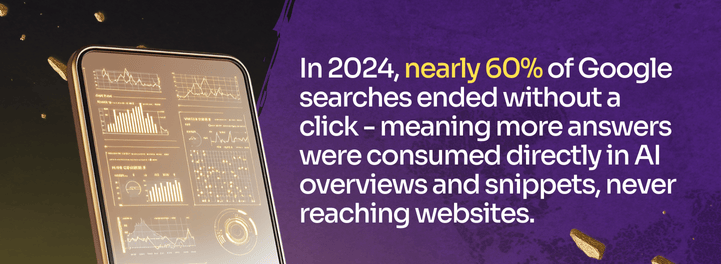Generative engines look for content that’s structured in a way a model can extract and cite: short definitions, clean lists, entities that map to knowledge graphs, and schema that confirms context.
If those elements are missing, your content is invisible in the places people are now getting answers.
This post gives you the GEO audit steps, the checklist, and the fixes that separate content LLMs can use from the kind they ignore.
Key Takeaways
- In AI search, there’s no second page of results. Either your content is structured well enough to be included in the answer, or it doesn’t appear at all.
- GEO audits show if your content is AI-friendly to be pulled into LLM answers.
- Traditional SEO checks rankings and backlinks; GEO checks if engines can parse, trust, and cite you.
- Missing schema, weak structure, or vague claims make your brand invisible in AI search.
- Elements like short definitions, bullet lists, comparison tables, and entity mentions dramatically increase the odds of inclusion.
- Running GEO audits regularly gives you a realistic view of your AI presence and a prioritized list of fixes to stay discoverable as search shifts.
Invisible in AI search - or actually being cited?
Find out with an AI Search Optimization audit.
What Is Generative Engine Optimization (GEO)?
GEO is about one thing: making sure AI can use your content. Not skim it. Not “rank” it. Use it - as a source inside an answer.
SEO tracks clicks and positions. GEO shows if your content is making it into answers from ChatGPT, Gemini, or Perplexity.
What GEO Changes
- 58% of U.S. adults have already encountered AI-generated summaries in Google results. That means more than half of searchers are seeing AI-written answers before they ever reach a site.
- A GEO audit tool shows you the reality: which prompts surface your content, which skip you, and where competitors are already present.
- The deciding factors aren’t complicated. Models look for schema, entity mentions, concise definitions, and verifiable sources. If those aren’t there, another site gets picked up in your place.
How GEO Differs from SEO
- Unit of value: SEO = clicks and rankings. GEO = citations, mention quality, and answer-readiness.
- Signals that matter: SEO = links, technical health. GEO = question-based headers, concise answers, schema markup, entity linking, and source-backed facts.
- Outcome: SEO improves discovery. GEO improves inclusion in AI answers.

What Is a GEO Audit and Why Should You Run One?
A GEO audit is a visibility test: put your content in front of the same prompts real users type into ChatGPT, Gemini, or Perplexity - and see what comes back.
What You Get Out of It
- A map of your AI presence - which prompts include you, which don’t.
- Accuracy check - when your brand is mentioned, is it quoted correctly or misrepresented?
- Competitive lens - who’s being surfaced in your place, and why.
- Fix list - specific structural gaps (schema, entities, definitions) that explain exclusion.
Instead of crawling backlinks and meta tags, a GEO audit looks at something else entirely: how AI systems use your content. That means checking answers in different engines, the sources they pull into knowledge bases, and the brand context they decide to surface.
The catch: models don’t work like Google’s ranking algorithm. They draw on a wider, messier mix of data - documentation, Q&A forums, structured entities, even third-party summaries.
And while some AI engines show partial sourcing, none give a full log of how they built an answer.
That’s why GEO audit services exist - to give you the closest view of how often your content is pulled into answers - and when the model turns to someone else instead.
Key Elements to Audit for GEO Success
| Element | What to Check | Why It Matters in GEO | Common Gaps Found in Audits |
| Structured Content & Headings | - Clear H2/H3 hierarchy- Use of bullet lists, tables, definitions | Models reuse chunks of content, not paragraphs. Structure makes extraction simple and reliable. | Pages with dense text, no subheadings, or inconsistent formatting get skipped. |
| Entity Linking & Schema Markup | - Consistent naming of brand, products, people- Valid schema (Article, Product, FAQ)- Internal/external entity connections | AI engines lean on entities + structured data to anchor meaning. Schema gives them explicit machine-readable signals. | Missing or invalid schema; inconsistent product names; brand referenced differently depending on the channels. |
| Factual Consistency & Source Attribution | - Are stats updated and uniform on every page?- Are claims tied to a verifiable source?- Is attribution clear when citing third parties? | Engines down-rank or ignore sources with contradictions. Reliable, attributed data increases citation likelihood. | Conflicting numbers on pages; no citations for claims; vague or unlinked references. |
| Semantic Depth & Topic Coverage | - Does content address “what, why, how” around a query?- Are related subtopics included (use cases, comparisons, edge cases)? | Generative engines reward content that covers a topic broadly enough to write a full answer. Thin content = skipped content. | Overly narrow posts; lack of examples; missing context for FAQs or comparisons. |
| Content Clarity & Tone of Voice | - Are explanations written in plain, natural, conversational language?- Does copy reflect how real users phrase questions?- Is jargon minimized? | Models favor clarity because answers need to align with user prompts. Conversational content is easier to reuse in AI-generated text. | Jargon-heavy copy; long, academic-style sentences; no alignment with how questions are actually asked. |
A GEO audit isn’t just about if you’re visible. This table shows why engines choose one source over another. Each row is a visibility lever - fix the gaps, and your odds of being cited increase.
What Platforms & Tools Can Help You Run a GEO Audit?
A GEO audit only works if you can see what the engines see. That means testing your content against the same prompts users ask, checking if schema holds up under validation, and tracking whether your brand shows up in the answers or disappears in the rewrite. AI visibility tools below make that possible.
AI Answer Tracking
- Nozzle.io - Tracks how often your brand, URL, or phrasing appears inside ChatGPT answers. Even catches paraphrased mentions without links. Use it to measure visibility shifts after content changes.
- Profound - Built for measuring how often and in what way your brand appears in AI outputs across many LLMs. Tracks brand mentions, citation context, how AI “sees” your content.
- Otterly.ai - Designed for tracking visibility of your brand / product in AI tools. Focused features like mention detection and monitoring how models reference your site.
Schema Validators & Generators
- Google Rich Results Test - Validates if your schema is implemented correctly and eligible for search features.
- Schema.org Validator - Double-checks structured data compliance with schema.org standards, the language most AI systems parse.
- Yoast / Rank Math – WordPress plugins that automate schema, apply internal links, and keep formatting structured for all your content.
Prompt Testing
- ChatGPT Prompt Testing - Run queries like “What is [topic]?” or “Who explains [topic] well?” and check if your phrasing or brand appears. Variations in GPT-4o, GPT-4, and free models reveal where you’re missing.
- Perplexity.ai - Query your category or product terms and scan its citation panel. One of the cleanest ways to see if your domain is “source material.”
- Claude.ai - Strong at longer, research-style queries. Test if your site gets referenced when it’s asked to explain trends, comparisons, or definitions in your space.
- Microsoft Copilot - Integrated with Bing search. Run prompts to see if your content is cited in AI overviews and sidebar answers, especially for commercial or “how to” queries.
Entity Mapping & Brand Consistency
- Kalicube Pro - Maps entities (brand, product, people) on your site and external platforms like LinkedIn, Crunchbase, or Wikipedia. Essential for making sure AI models recognize your brand consistently.
- InLinks - Specializes in internal entity linking and semantic markup. Helps align your content with knowledge graphs so AI engines see you as authoritative.

GEO Audit Checklist (Practical Steps)
Generative engines don’t grade your writing style. Use this GEO audit checklist to see if your pages give LLMs what they need to reference you instead of a competitor.
| Step | What to Do | Why It Matters for GEO |
| ✅ Structured H2s & Bullets | Phrase headers as natural questions, break ideas into bullets. | LLMs look for prompt-like headers and modular answers. Dense paragraphs get skipped. |
| ✅ Entities & Semantic Terms | Work in brand names, products, people, and related terms. | Engines map entities into knowledge graphs. Missing them means you’re harder to cite. |
| ✅ Source-Backed Facts | Add stats and link to authoritative references. | Models prefer factual, attributed claims - reduces hallucinations and builds authority. |
| ✅ Prompt Testing | Run real queries in ChatGPT, Gemini, or Perplexity and see if you show up. | No substitute for seeing what the model actually returns. |
| ✅ Ongoing Monitoring | Track mentions and visibility shifts with tools like Profound or Nozzle. | LLM indexes refresh often - if you’re not monitoring, you won’t notice when you drop out. |
PRO TIP
Start with structure (headers, bullets), then add entities and sources, and only after that run prompt tests. Structure is the fastest win; sources and schema are what lock in long-term visibility.
Common GEO Audit Mistakes to Avoid
A GEO audit should expose where your content falls short of what LLMs look for.
These are the patterns that make your pages invisible in generative search - and the fixes that keep you in the results.
- Keyword Stuffing
Generative engines interpret structure and relationships, not raw density. If your phrasing doesn’t connect to entities or categories, the keywords are wasted space.
- Ignoring Entity Relationships
Simply stating your brand or product name, with no connections, doesn’t earn citations. LLMs rely on the web of connections (industry, category, related concepts) to decide whether you’re authoritative.
- Skipping Schema
Schema markup is one of the simplest data points you can add, yet it’s still missing from a huge number of pages. Structured data doesn’t guarantee placement, but it makes it far easier for engines to classify FAQs, HowTos, or products.
- Thin or Vague Content
LLMs want bite-sized, factual snippets they can lift directly. A short page with broad statements and no sources is almost guaranteed to be skipped.
- Not Testing in Multiple Engines
Checking ChatGPT alone won’t cut it. Gemini, Perplexity, Claude, and Copilot all pull from different sources. If you’re not testing prompts in more than one engine, you’re blind to half the places customers may find (or miss) you.
- Overlooking Factual Consistency
If your site cites three different numbers for the same metric, which one should an LLM trust? Conflicting stats reduce reliability. Models are more likely to grab a competitor with cleaner, standardized data.
- Weak Internal Linking
Pages cut off from the rest of your site aren’t just hard for humans to find - they’re also harder for AI to understand in context. Internal linking establishes hierarchy and topical clusters. Without it, your site looks fragmented.
Once the fixes are in place, the final step is measuring impact. AI visibility tools show if your optimization is recognized by AI engines.

Wrap Up
Generative Engine Optimization changes what it means to “show up.”
Search used to be about rankings and clicks; AI-first search is about citations and credibility.
If your content can’t be parsed and reused in an answer, you’re not in the conversation - no matter how strong your old rankings look.
A GEO audit shows if your pages are structured, entity-linked, and consistent enough to appear in ChatGPT, Gemini, Perplexity, or Copilot. Models refresh constantly, so continuous GEO optimization is the only way to keep your presence stable.
Google’s AI Overviews doubled in visibility between January and March 2025, now showing up in over 13% of U.S. desktop searches. That’s not a test phase - that’s the future of discovery.
Frequently Asked Questions
What is a GEO audit?
A GEO audit is a structured review of your content to see if large language models (LLMs) can use it. Instead of ranking signals like backlinks, a GEO audit tool looks at schema, entity mentions, formatting, and factual consistency to judge whether your pages are answer-ready.
How is a GEO audit different from a traditional SEO audit?
An SEO audit checks discoverability (keywords, rankings, backlinks). A GEO audit checks usability - if generative engines like ChatGPT, Gemini, Claude, or Copilot can parse, cite, and reuse your content in their answers.
Do GEO audit services improve SEO too?
Yes. Structured content, schema markup, and entity linking are all GEO moves that also strengthen your SEO. Optimizing for AI visibility tools usually reinforces your rankings in Google and SGE at the same time.
How often should you run a GEO audit?
At least once every 6 months - or sooner after major AI model updates. LLMs retrain constantly, and your brand’s presence inside their outputs can shift overnight.
Can I test my own content without a paid GEO audit tool?
Yes. Start with prompt testing: ask ChatGPT, Perplexity, or Gemini the questions your audience is asking and see if your brand shows up. From there, free schema validators and entity mapping tools can highlight gaps. Paid GEO audit services go deeper with tracking, reporting, and competitor benchmarks.
What are the most effective providers for a generative engine optimization audit?
The best GEO audit services combine detection, schema implementation, and competitor benchmarking. Some focus on tools (AI visibility platforms that track mentions across LLMs). Others are agencies that run full-service GEO audits, layering in strategy and recommendations. The “best” provider depends on your goals.
Who offers the best value GEO audit services with actionable recommendations?
Value comes down to implementation. The best providers deliver not just diagnostics but actionable changes: updated schema, entity maps, rewritten definitions, or structured FAQs that increase your odds of being cited in generative answers.
What should I look for when comparing GEO audit packages?
Strong GEO audit services test your brand in multiple engines, fix structural gaps like schema and entities, and prove results by showing where your content surfaces in AI answers. Anything less is just a checklist.
Where can I find agencies specializing in GEO audits for e-commerce?
E-commerce sites benefit most from GEO audits that prioritize structured product data, consistent pricing, and schema for product pages. Look for firms with case studies in retail or SaaS, not just generic SEO.





